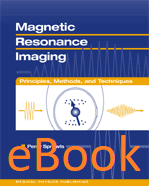
Magnetic Resonance Imaging: Principles, Methods, and Techniques, eBook
Author: Perry SprawlsISBN: 9781951134044
Published: 2000 | 200 pp | eBook
Price: $ 45.00
Radiology | November 2001
"This is a visually stimulating book. Like Dr. Sprawl's other books, Magnetic Resonance Imaging is full of great illustrations that convey a tremendous amount of information in manageable form. However, this book takes the concept of great illustrations one step further by using a device called a 'mind map.' The concept of 'mind mapping' has been a hot topic in educational circles in recent years (Burzan T, Burzan B. The mind map book. New York, NY: Dutton, 1996; Margulies N. Mapping inner space learning. Tucson, Ariz: Zephyr, 1991). It is baaed on the idea that most humans have far better pictorial memory than textual memory. Also, most of us feel more confident in our knowledge if we can construct relationships between ideas. A mind map is a diagram that shows these relationships. In this book, mind maps appear at the end of each chapter. Clever use of recurring icons is made in these maps to represent concepts like precession and radio-frequency signals. This device aids readers in transferring knowledge from one context to another as they work their way through multistep processes such as image acquisition.
"Many educators believe that the understanding of basic concepts should be emphasized before equations are shown. This book is an impressive attempt to solidify basic concepts without using equations. For example, no Larmor equation is given. Instead, a table of "Larmor frequencies" in a magnetic field strength of 1 T is given. There are no equations for exponential decay of the magnetic resonance (MR) signal, no footnotes, no references, and no problems to solve at the ends of the chapters. This is a concise, uninterrupted, nonmathematical, textual explanation with lots of 'ah ha! I get it now' illustrations knitted together by mind maps. Given the format, it is amazing how many advanced concepts this book covers. The topics include diffusion-weighted imaging, MR angiography, and half Fourier imaging, in addition to the basics of precession, chemical shift, and two-dimensional Fourier transform image reconstruction.
"There should be no disagreement with the statement that this book is definitely for those who do not need to acquire an in-depth technical or mathematical knowledge of MR imaging. It is certainly appropriate as a general introduction for technologists. However, I suggest that it is also suitable as a first step for those who will eventually need more technical knowledge (eg, radiology residents). I will definitely lend my copy to residents who are struggling with concepts such as k space and two-dimensional Fourier transform, for example. In any case, those who teach MR principles at any level will find the illustrations in this book to be great source material for lectures.
"In summary, I think that this book will be helpful to many students at many levels. Some instructors who have not been involved with undergraduate education for a long time may be put off by the lack of 'traditional textbook' structure. To them, I recommend going to a university bookstore and looking up introductory texts for the sciences. Textbooks have changed over the decades, and the people we are teaching at the present time learned basic science from books that are structured more like this one than the traditional textbooks from which we learned years ago. To be sure, physics and engineering courses for science majors use texts (and notes, software, and Web sites) with as many equations as ever.
"No one starts out learning about science and engineering at the graduate level. This book helps with that big first step."
Reviewed by E. Russell Ritenour, PhD


